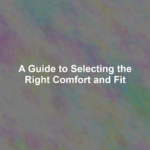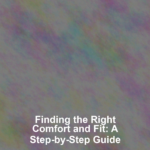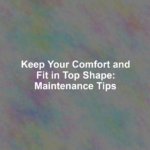Navigating the world of clothing and footwear is akin to exploring a dense forest; without the right compass, you might just lose your way.
YouG??ve likely experienced the discomfort of a poor fit, whether itG??s shoes that pinch or jeans that restrict your movement. To ensure youG??re dressed in comfort and style that suits you, itG??s essential to arm yourself with knowledge.
Your measurements are the cornerstone of this quest, yet theyG??re not the sole factors to consider. The materialG??s quality, your body shape, and the specific activities youG??ll engage in also play pivotal roles.
As you prepare to outfit yourself for lifeG??s adventures, remember that the right fit isnG??t just about sizeG??itG??s an art that balances form and function. Stay with us to uncover how you can master this art, making every piece of clothing or pair of shoes you choose feel like it was tailored just for you.
Know Your Measurements
To ensure the perfect fit, itG??s essential that you accurately measure your bodyG??s dimensions. You wouldnG??t want to end up with clothes that are too snug or uncomfortably loose. Start by getting a flexible tape measure; itG??s your best ally in this mission.
Measure your chest by wrapping the tape around the fullest part, usually across your nipples. DonG??t puff out your chest or suck it in; just stand normally.
Next, youG??ll need your waist measurement. Find your natural waistline, typically an inch above your belly button, and wrap the tape around without holding your breath. For your hips, locate the widest part around your buttocks and measure there.
If youG??re measuring for pants, donG??t forget your inseam. Stand straight and measure from your crotch down to where you want your pants to end. This is crucial for getting the right pant length.
Prioritize Material Quality
When selecting clothing, always consider the quality of the material as it directly affects comfort and durability. YouG??ll find that high-quality fabrics not only feel better against your skin but also tend to last longer, saving you money in the long run. ItG??s tempting to opt for cheaper items, but they often lead to discomfort and frequent replacements.
Think about the purpose of your clothing. Are you looking for workout gear? YouG??ll want something breathable and moisture-wicking. In need of professional attire? Look for materials that hold their shape and resist wrinkles. DonG??t forget to check the labels – natural fibers like cotton, wool, and silk typically offer more breathability and comfort than synthetics, but they may require more care.
Also, consider the texture of the fabric. If youG??ve got sensitive skin, scratchy materials can be a nightmare, no matter how good they look on the hanger. Take the time to feel the fabric and do a bit of research on how it wears over time. Remember, investing in quality material means youG??re investing in your comfort and wardrobe longevity. Choose wisely and you wonG??t regret it.
Understand Body Shape
Recognizing the importance of material quality, itG??s equally crucial to understand your body shape to find clothes that offer the best fit and enhance your comfort. Your unique silhouette plays a significant role in how apparel sits and moves on you. ItG??s not about changing your shape but celebrating it by choosing pieces that flatter you the most.
Consider these essential tips:
- Identify Your Shape: Is it pear, apple, rectangle, hourglass, or a unique mix? Each shape has its highlights, and knowing yours helps pinpoint which clothing styles will complement you.
- Balance Proportions: Aim to create a visual balance. For example, if you have broader shoulders, you might opt for A-line skirts to even out your silhouette.
- Highlight Your Assets: Choose clothing that accentuates the features you love. Love your waist? Belted dresses can be your go-to.
Check Sizing Charts
Navigating sizing charts is essential for ensuring that your clothing choices not only flatter your shape but also provide maximum comfort. DonG??t assume youG??re the same size across different brands; thereG??s often variation. Before you click G??buyG?? or head to the dressing room, take your measurements and compare them to the provided sizing chart. Keep a tape measure handy and measure your bust, waist, hips, and inseam. Remember, sizes can differ internationally, so check the chart every time.
When youG??re looking at these charts, pay attention to the fit descriptions. Terms like G??slim,G?? G??regular,G?? or G??relaxedG?? indicate the cut of the clothing. YouG??ll want to choose a cut that complements your understanding of your body shape from the previous step. Also, consider the fabric type. Stretchy materials may allow you more leeway in sizing, while non-stretch fabrics wonG??t have that give.
Lastly, read customer reviews for insights on sizing accuracy. Other shoppersG?? experiences can guide you to size up or down. ItG??s better to spend a few minutes reviewing the charts than to deal with the hassle of returns. Get those sizing charts right, and youG??ll enjoy your new clothes to the fullest.
Consider Activity Needs
Consider your planned activities to ensure the clothing you select offers the appropriate range of motion and comfort for your needs. Whether youG??re gearing up for a marathon, setting off on a hiking adventure, or prepping for a casual day out, your outfit should match the occasion. You wouldnG??t wear stiff jeans on a run, just like you wouldnG??t choose delicate fabrics for a rugged trail.
When choosing clothing based on your activities, keep in mind:
- Fabric choice: Opt for moisture-wicking materials for vigorous activities to help keep you dry and comfortable.
- Fit flexibility: Ensure thereG??s enough stretch or looseness for full body movement without restrictions.
- Durability: Look for sturdy construction and strong materials if youG??re engaging in activities that could be rough on your clothing.
ItG??s all about balance. You want clothes that move with you but wonG??t get in the way. So, try on different options and mimic the movements youG??ll be doing. If youG??re shopping online, read reviews to see if others have successfully used the clothing for similar activities. Remember, the right outfit not only looks good but also enhances your performance and overall experience.
Conclusion
Now that youG??re equipped with your measurements, appreciate the importance of material quality, understand your body shape, and know how to navigate sizing charts, youG??re all set to find the perfect fit.
Remember to consider your activity needsG??comfort isnG??t just about size, itG??s also about suitability. Trust your instincts and donG??t compromise on comfort.
With these tips, youG??ll choose apparel that feels like itG??s made just for you. Happy shopping!










